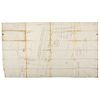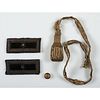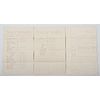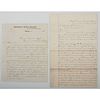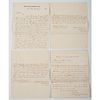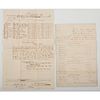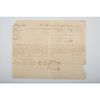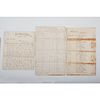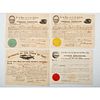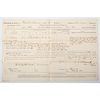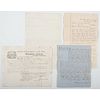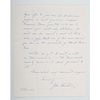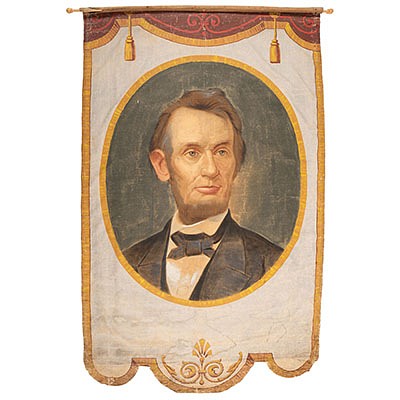[CIVIL WAR]. RICHARDSON, Brigadier General William P. (1824-1886). An archive of materials related to Richardson's service in the 25th Ohio Infantry a
About Seller
6270 Este Ave.
Cincinnati , OH 45232
United States
With offices in Cincinnati, Cleveland and Denver, Cowan’s holds over 40 auctions each year, with annual sales exceeding $16M. We reach buyers around the globe, and take pride in our reputation for integrity, customer service and great results. A full-service house, Cowan’s Auctions specializes in Am...Read more
Two ways to bid:
- Leave a max absentee bid and the platform will bid on your behalf up to your maximum bid during the live auction.
- Bid live during the auction and your bids will be submitted real-time to the auctioneer.
Bid Increments
| Price | Bid Increment |
|---|---|
| $0 | $25 |
| $500 | $50 |
| $1,000 | $100 |
| $2,000 | $250 |
| $5,000 | $500 |
| $10,000 | $1,000 |
| $20,000 | $2,500 |
| $50,000 | $5,000 |
| $100,000 | $10,000 |
About Auction
Jun 25, 2021
The June 25 American Historical Ephemera and Photography Auction features an exciting assemblage of 18th-early 20th century material, including Civil War archives, Early Photography, Western Americana, Autographs and Manuscripts, and more. Cowan's Auctions dawnie@cowans.com
- Lot Description
Approx. 126 documents spanning 1840s-1969 (approx. 100 war-date). Civil War-era documents encompass the early days of the Ohio 25th Infantry regiment, Richardson's time as commander of Camp Chase military prison, and his subsequent position as commander of the Department of East South Carolina. Highlights include a "Plan of the Camp [Chase]" submitted to Brig. General Richardson by A.Q.M. Thomas J. Kerr, 37.25 x 21.5 in., 22 March 1865, outlining in detail locations for camp buildings as well as the "New Prison" and drainage ditch built to improve overall sanitation and prisoner health; letters submitted by Dr. Richard H. Coolidge, Medical Inspector of the Northern Department, to Richardson, examining sickness and mortality of prisoners at Camp Chase; and a 12-page letter written by Richardson to an unidentified general on 5 January 1866 in which he details conditions in the state of South Carolina specifically as they pertain to white attitudes regarding slavery and the status of freedmen in South Carolina. Provenance: Archive descended directly in the family.
[With:] 16.75 x 13.75 in. large oval albumen of William Pitt Richardson as a brigadier general as indicated by straps with a single star (approx. 1.5 in. tear center right, scattered surface loss and abrasions); Civil War period brigadier general shoulder straps (wear, loss to top center of star on one strap); remnants of a general officer's sword knot and a uniform button; the "Muster-In Roll" of Colonel W.P. Richardson, 25th regiment of Ohio Veteran Volunteers, 5 July 1864; appointments signed by Ohio governors William MEDILL (in office 1853-1856), William DENNISON (in office 1860-1862), David TOD (in office 1862-1864), and John BROUGH (in office 1864-1865); various special orders related to Richardson's service including an ALS from Governor Tod ("David Tod") to Richardson, Columbus, [OH], 21 September 1863, in which Tod directs Richardson to report to him for duty, and Special Orders No. 12 directing Richardson to relieve Col. William Wallace from command at Camp Chase; and a letter from Richardson's brother-in-law, Lt. E.A.E. Smith, Co. A, 36 Virginia Regiment, written to Sarah (Smith) Richardson while he was a POW at Fort Delaware, 8 December 1864.
[Also with:] Miscellaneous legal documents associated with Richardson's work as an attorney; newspaper clippings; miscellaneous family correspondence and genealogical documentation; leather-bound autograph album of Sarah Elizabeth Smith Richardson, ca 1840s-1850s; a post-war CDV identified on verso as "Gen. W.P. Richardson / Marietta O."; cabinet card of a well-dressed woman with inscription on verso "To W P Richardson / From his Sister / Sarah R. Angle / May 25th 1884"; and an albumen studio portrait of an unidentified young man, dated 1913.
William Pitt Richardson was born on 25 May 1824 in Washington County, PA. After graduating from Washington College in 1844, Richardson moved to Ohio to be a teacher. In 1846, he enlisted as a private in the Third Ohio Infantry and served in the Mexican-American War. Following the war, he studied the law and was admitted to the Ohio Bar in 1852. He was elected Prosecuting Attorney of Monroe County, Ohio, a position he held until the start of the Civil War along with the rank of Brigadier General in the Ohio Militia. After the attack on Fort Sumter, Richardson raised two companies that were ultimately assigned to the Ohio 25th Infantry. HDS indicates that on 6/22/1861 Richardson enlisted as a Lieutenant Colonel of the 25th Ohio, a regiment that participated in multiple key engagements of the war including the Second Battle of Bull Run, Chancellorsville, and Gettysburg. Lt. Col. Richardson commanded the regiment at the Battle of McDowell and Battle of Cross Keys. He was seriously wounded in the right shoulder at Chancellorsville on May 3, 1863, an injury that permanently deprived Richardson of the use of his right arm. In February 1864, he was placed in command of Camp Chase where he remained through August 1865. Though he was elected Ohio Attorney General in October 1864, he resigned the post shortly after taking office. Richardson was promoted by brevet to Brigadier General on Dec 7, 1864. Following his service at Camp Chase, he was assigned to duty in South Carolina where he commanded the District of East South Carolina. He was discharged 5/9/1866.
The earliest war-date documents relate to the 25th OVI, and predominantly include sworn statements of account certifying receipts of goods from the US government as well as listings of items purchased by staff officers. One incomplete letter, 17 October 1861, and addressed to "Hon. S.P. Chase / Secy. of the Treasury," describes the status of Ohio regiments, with the unknown author indicating that "I am not satisfied with the manner in which Ohio troops are treated in Western Virginia," and continuing "I desire to avoid saying anything that may create jealous or ill feelings between Ohio and Indiana troops, but I have silently bourne [sic] as long as my self respect and the dignity of my state will permit what I cannot but regard as favoritism to Indiana."
Camp Chase documents include lists of ordnance and ordnance stores (1864-1865), a "List of Articles Lost or Destroyed" at Camp Chase in June 1864, and a "List of Mess House Property sold at Public Auction under direction of Bvt Brig General W.P. Richardson Comdg post Camp Chase O on the 29th July 1865." More interesting material includes a group of two documents relating to the possibilities of illegal activities undertaken by Camp Chase sutlers; two "Surgeon Certificates" signed by Albert Longwell, Surgeon, 88 OVI, detailing services rendered to two rebel soldiers with gunshot wounds; a statement from Lt. P. Ivory, 2nd Lt. Co. I, 88th OVI, describing a July 1864 incident in which a prisoner was shot by a guard; and a letter from Alex Sankey, 88th OVI, Lt. and Pro. Mar. of Prisoners, describing another July 1864 incident where a prisoner was shot. These last letters are noteworthy because it was in part due to cases of POWS being fatally wounded in the Camp Chase barracks that Richardson's predecessor, Col. William Wallace, was relieved of his command.
Perhaps most significant amongst the Camp Chase documents is the map of Camp Chase provided to Richardson by Lt. Col. Thomas J. Kerr., 88th OVI and later US Quartermasters Department. As part of the Union Army's larger effort to address inadequacies in the prison system, Richardson was tasked with improving conditions at Camp Chase. Kerr's 4pp letter to Richardson on 22 March 1865 is, in part, a statement of actions undertaken since 1864 to improve conditions at the Camp Chase. He discusses building additional barracks and improvements to drainage. He notes enclosures identified "A" through "E," with "B" ("Statement of Number Size and Kind of Buildings at Camp Chase Ohio"), "C" ("Statement of number of size of barracks for Prisoners of War at Camp Chase Ohio"), and "E" the "Plan of the Camp" included in the archive. Richardson, who supervised the rebuilding of Camp Chase in 1864 and efforts to more adequately feed and clothe the prisoners, earned the respect of his prisoners and fellow soldiers for his competent efforts. Camp Chase was widely recognized as one of the most ably administered camps in the North.
Following his command at Camp Chase, Richardson moved to South Carolina as part of the Union's occupation and reconstruction efforts. In his 12pp letter to an unidentified general, Richardson describes conditions in the Military District of South Carolina. This letter is exceptionally detailed and noteworthy for its lengthy discussion of Southern racism and the myriad difficulties facing freedmen. In describing his duties, Richardson states, "The most laborious and responsible part of our duties are those that relate to the control and protecting freedmen and endeavoring to successfully establish the new system of labor...Emancipation was the result of this war, was forcible, and against the inclinations, opinions, and prejudices of the people...southern people have always much to say about the radicals and fanatics of the north, yet I think it certain that they, themselves, are the most radical and fanatical of all people in the world, when they think, talk, or act with reference to the colored race...The only hope they seem to entertain is the repression of the whole race..." The letter turns then to a discussion of Union efforts to foster new systems in planting and new schools. He remarks, "I have no doubt of the intention and desire of the freedmen now to live quietly and to be honest and industrious, and if they do so, and the planters treat them kindly and deal fairly with them, a new era of great prosperity and happiness is near at hand for both white and colored."
AN IMPORTANT ARCHIVE HIGHLIGHTING NOT ONLY RICHARDSON'S SERVICE, BUT CAMP CHASE, THE EVOLUTION OF UNION PRISON POLICY, AND THE CHALLENGES OF RECONSTRUCTION. - Shipping Info
-
SHIPPING & PICKUPS Cowan’s Cincinnati Office offers an in-house, full-service shipping department which is unparalleled in the auction industry. Shipping costs are provided with your finalized invoice 24-48 hours after auction. For furniture and oversized items, we recommend using third-party services. For more information, contact cowansshipping@hindmanauctions.com. NOTE: All pickups and preview are by appointment only. To make an appointment, please call 513-871-1670 or email cincinnati@hindmanauctions.com Buyers are required to pay for all packing, shipping and insurance charges. Overseas duty charges are the responsibility of the successful Bidder. Be aware that for larger and/or valuable items, shipping charges can be substantial. - Shipping charges include insurance for your order while in transit. If you have private insurance we will adjust your charge to include only packing and shipping. - Please allow 14 – 21 days after payment to package and ship your purchase as carefully as possible.
-
- Buyer's Premium



 EUR
EUR CAD
CAD AUD
AUD GBP
GBP MXN
MXN HKD
HKD CNY
CNY MYR
MYR SEK
SEK SGD
SGD CHF
CHF THB
THB![[CIVIL WAR]. RICHARDSON, Brigadier General William P. (1824-1886). An archive of materials related to Richardson's service in the 25th Ohio Infantry a](https://s1.img.bidsquare.com/item/l/8589/8589741.jpeg?t=1LMY7m)
![[CIVIL WAR]. RICHARDSON, Brigadier General William P. (1824-1886). An archive of materials related to Richardson's service in the 25th Ohio Infantry a](https://s1.img.bidsquare.com/item/s/8589/8589741.jpeg?t=1LMY7m)
